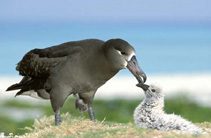Phoebastria nigripes (Audubon, 1839)
Black-footed albatross
Classification / Names Common names | Synonyms | CoL | ITIS | WoRMS
Aves | Procellariiformes | Diomedeidae
Environment: milieu / climate zone / depth range / distribution range Ecology
Others. Subtropical
Distribution Countries | FAO areas | Ecosystems | Occurrences | Introductions
Pacific Ocean and Northwest Atlantic: from the coasts of China, Japan and Russia eastward to continental North America. Tropical to temperate waters.
Length at first maturity / Size / Weight / Age
Maturity: Lm ? range ? - ? cm Max length : 81.0 cm TL male/unsexed; (Ref. 84934); max. published weight: 3.0 kg (Ref. 356)
Short description Morphology
Life cycle and mating behavior Maturity | Reproduction | Spawning | Eggs | Fecundity | Larvae
Main reference
References | Coordinator | Collaborators
Lepage, D. 2007 Avibase -the World Bird Database. http://www.bsc-eoc.org/avibase/avibase.jsp [accessed 09/07/2007]. (Ref. 7816)
IUCN Red List Status
(Ref. 130435: Version 2025-1)
CITES status (Ref. 108899)
CMS (Ref. 116361)
Threat to humans
Human uses
| FishSource |
Tools
More information
Max. ages / sizes
Length-weight rel.
Length-length rel.
Length-frequencies
Mass conversion
Abundance
Internet sources
BHL | BOLD Systems | CISTI | DiscoverLife | FAO(Publication : search) | Fishipedia | GenBank (genome, nucleotide) | GloBI | Gomexsi | Google Books | Google Scholar | Google | PubMed | Tree of Life | Wikipedia (Go, Search) | Zoological Record



